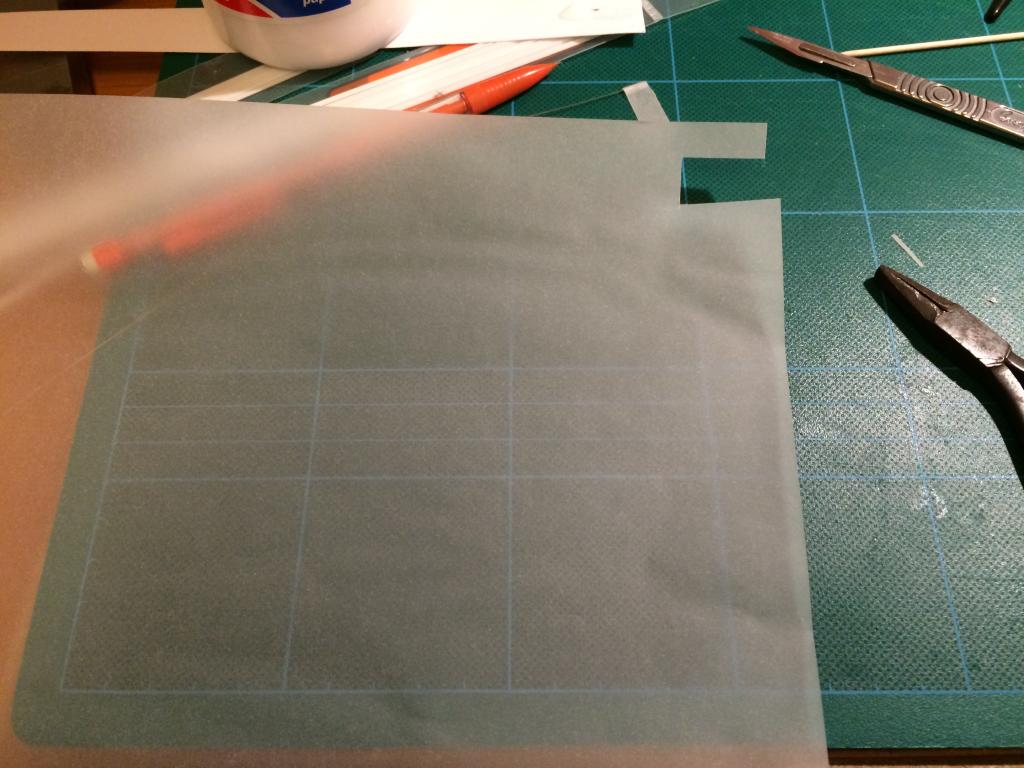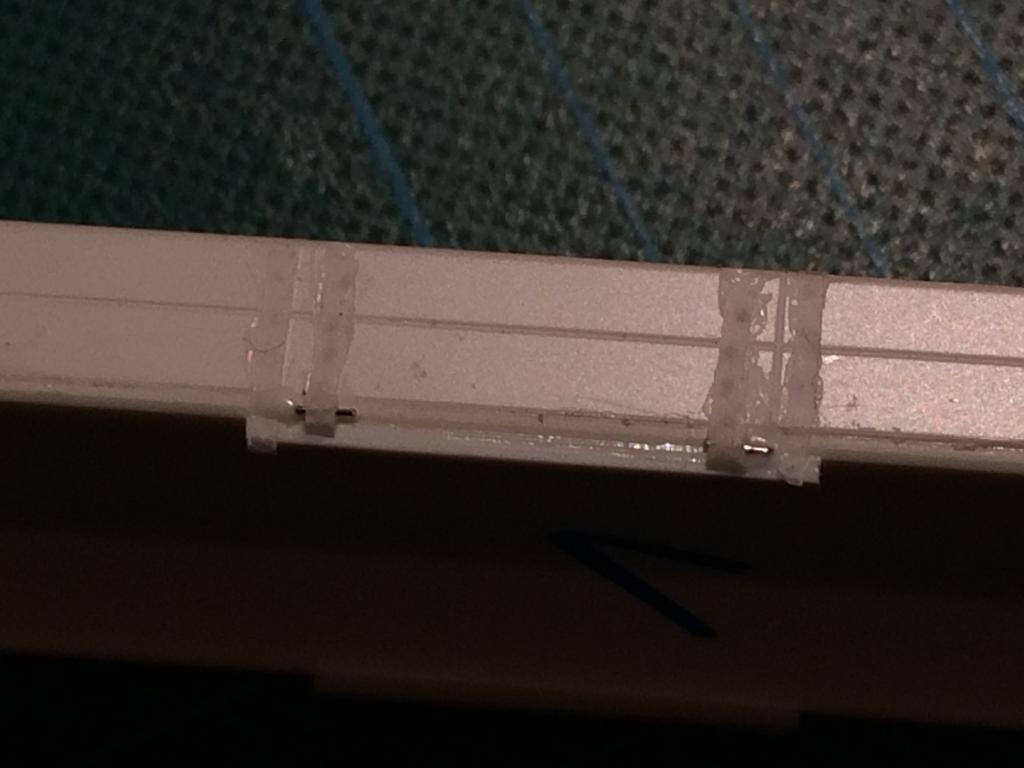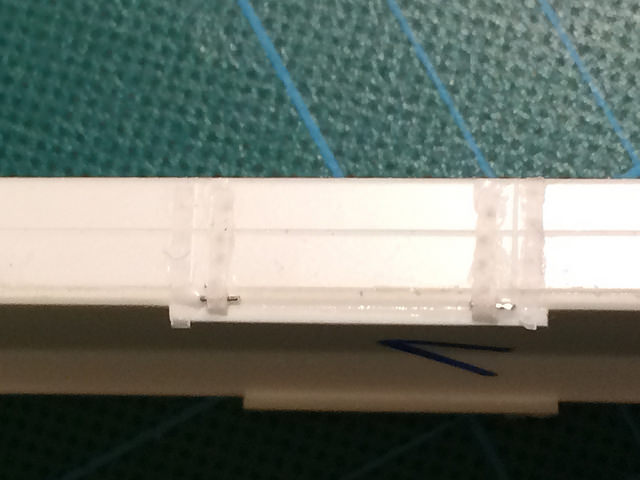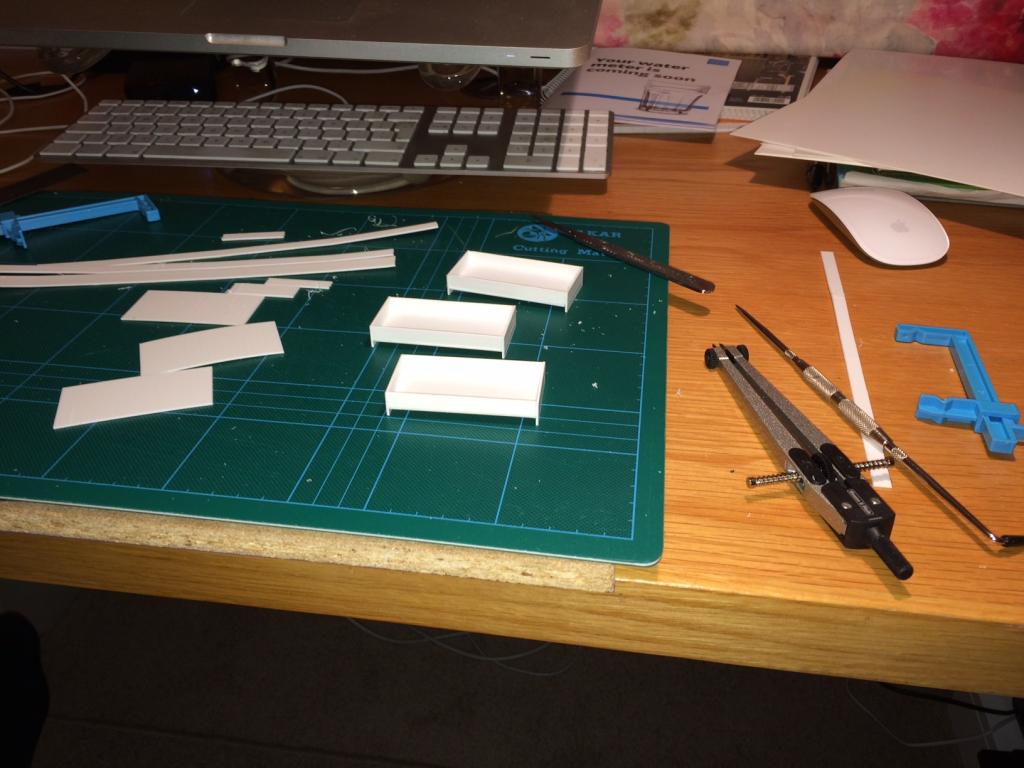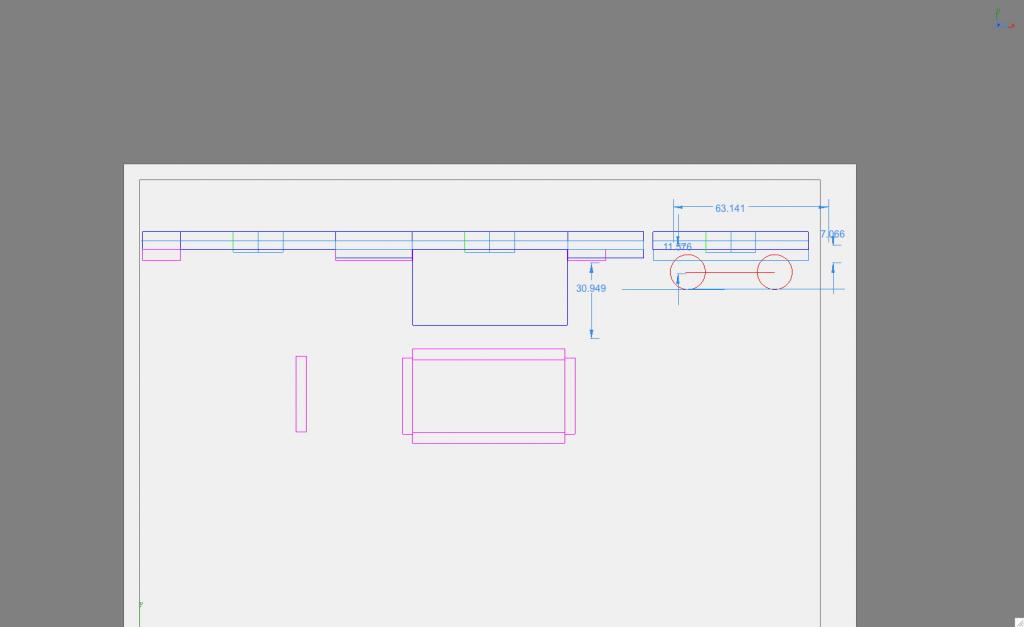
islandbridgejct
Members-
Posts
212 -
Joined
-
Last visited
Content Type
Profiles
Forums
Events
Gallery
Everything posted by islandbridgejct
-
She's a real beauty. Thanks for the livery information. I'd better get a bow pen and start practising - 6 wheelers are due to arrive soon, as are the bogies and sprung w-irons, so there'll be some serious building work to do. I'm working on a few Ratio midland suburban coaches at the moment for guinea pig purposes. I'll be practising painting them before I attack any brasswork with a paint can. Alan
-
Hi John, jhb, It will certainly be challenging to bring it back to 1910. I know about the sloping smokeboxes and curly running plates. The chimneys don't seem straightforward. Wheel spokes in the 101 seem to be LNWR pattern. I didn't know about the snap head rivets - I always thought they were a 1960s development. 4.4.0.s and 0.4.4.s are supposed to be very difficult to balance. I certainly won't be starting off with a taper boiler. But the locos have an awful lot of character and I'll just see what I can do. And then there's the lining.... I'm going to start off anyway with a few diesels as motive power, and some stock to suit them, and then try to backdate things gradually, so a Midland 0.6.0T from 1950 may be my first steam loco, plus a Bandon tank, both from Des. That'll get me underway, and I'll see how far I can take the concept. It's a bit like my use of P4 - if I can't make that work, I'll relax the standards to EM and keep the gauge; but I'll give it a go first. The main thing is that I'm not in a huge hurry, and I'm enjoying the building at the moment when I can make the time. I had no idea about the single Fairlie 0.4.4.T. It's not a pretty engine, and would be really difficult to model, but it shouts GSWR and I can see how it could grow on you. You could run a nice little BLT with 2 101s, a Kerry bogie, and maybe a Bandon tank. Thanks for all the advice and encouragement (and the entertainment.) It's much appreciated. Alan
-
Thanks John. I'll check out Design CAD in more detail, though it will need Parallels to run it. Draftsight has the advantage of being available for MAC, but is only 2D, and I wanted 2D and 3D functionality so I can get stuff dsigned for Shapeways. Incidetally, I got a 404 on the link to it, but found it via google at http://www.3ds.com/products-services/draftsight-cad-software/
-
I think it was HC Casserly, commenting on the 800 class, who said the drawing office got down to work, "delighted to be given their head after years of penny pinching," so that's your ancestor off the hook. Coey's big 4.4.0s with their tapered boilers were real beauties, and are a big attraction, though I'd need a section of the main line to run them, which would mean 8 coach trains which might be more than I can manage. Maybe something a bit smaller to start with. Castle Rackrent is a great layout, from what I've seen of it. I haven't managed to get a copy of the MRJ it appeared in, but I did get the update on it a few years back, and Peter Tatlow has a section on it in his Highland Miscellany (http://highlandmiscellany.com/tag/castle-rackrent/). Castle Rackrent seems to follow the Somerville and Ross theme, with charming natives and foxhunting anglos, something I want to avoid; but the modelling is top notch, and the operating principles sound really interesting. I'm not sure if the concept is that the C&CIR extended on north from Kilkenny, or is it based on the WLWR and intended to span from Waterford up to Athenry and beyond. There has to be some reason for putting the GSWR, WLWR and MGWR in one system. Is the depiction of GSWR wagon black correct? The current project is to make enough wagons to run a train or two. I have two of Mr Murphy's Bs, one of them converted to 21mm gauge and ready to roll. I've an A and a C from Q Kits to rehabilitate and - appropriately - re-engine, so I could have a temporary phase of GSWR stock with 1960s haulage, or maybe a multi-era layout. Baltimore and Bantry are lovely small termini, both located on a dock. I could have fish traffic and a weekly passenger steamer to Castletownbere - maybe a Summer tourist train with first class passengers heading to a Parknasilla style resort. No charabancs though - they'll definitely be banned. I'd need the CBSCR to get into bed with the GSWR a bit earlier too - but it seems they were happy enough to in 1924, so why not in 1910? No hurry though - got to build up the stock and skills first. Alan
-
So last night, I gave myself a bit of a fright. This is a tube of PVA glue: This is a sheet of layout paper. It's basically like greaseproof paper - it's very dense and very thin: This is a piece of paper being wrapped around a bit of brass wire, stuck together, rolled, and embossed with rivets: And this is a 2 plank wagon with the ironwork for the doors attached: The camera zoom is a cruel mistress, showing up the messiness of my glue application. Got to tidy that up. This wagon is already consigned for scrapping. In my enthusiasm the other night, I forgot to shorten the body sides to take account of the greater thickness of the styrene ends, and had 3 made before I realised. The remaining 3 were shortened, but one of them is of rather poor quality, so that's 2 out of 6 acceptable. Anyway, it has the appropriate 'V' scrawled on it, and will be useful for practice. What's bothering me about all this is that I've just realised I've become a rivet counter. Help! Is there a railway to Damascus?
-
Thanks, jhb. I've been following all your livery posts with interest. I think if I wanted properly colourful, I'd have to try to model platforms 6 and 7 at Amiens Street about 1950, occasionally moving to 1951. I could have green moguls, 4-6-0s coming in to take the Enterprise away to Cork, blue GNR locos, and a clatter of south eastern tanks. Plus the CIE carriage livery is a big attraction. 1951 would see colourful biscuit tins. Personal prejudices come into play in a big way. First, I like 6 coupled tender engines. I don't like tank engines - proper engines have tenders. I think CIE wrecked the Southern engines' lines with their catches all round the smokebox door (and they're probably unmodellable.) I like superheated engines with extended smokeboxes, but think the McDonnell double smokebox doors are cuter. The attraction of 1910(ish) is that the GSWR had some largeish 4-4-0s and bogie coaches were coming in. The Rosslare link was completed. I could stretch a point, maybe move back to 1907, defer the takeover of the WLWR to 1905 and also defer the application of lined black to locos to then. That would give me green, black and red locos, bogie coaches and 6 wheelers, and black wagons, and the railways would be in full flight, rather than in decline. On a less superficial level, I'm wondering what story I'd like the layout to tell - is this Joyce's Dublin, Plunkett's Strumpet City, Somerville and Ross's Cork, or my grandfather's story about "the very depressed state of the country at the time." Will I do the poverty or the twee Oirish thing? Probably the poverty - I'll leave the faith and begorrahs to someone else. The other attraction of 1910 is that I think the motor car ruined the countryside and the city, and I want to get away from it in my modelling because you can't get away from it in reality - there's traffic noise everywhere, even 5 miles from a main road you can hear the hum if the wind drops. I think that's a shame. There you go, more than enough prejudices to start a fight. Any thoughts? (I'm off to look at me wagons.)
-
Curse of the Mac user, I'm afraid. I could use AutoCad on Parallels, but I'd need a bootleg copy (did I really just say that?) and I'm afraid the weight of AutoCad on Parallels would give my poor Mac a hernia. So I might just have to stick with little piggy.
-
To be fair to Schrodinger, at least when his cat was dead it was dead, we just didn't know. I gather Schrodinger's dead too, or at least he may be. Turbocad is like a cave full of bat droppings - it's a complete bugfest. When it opens, it sprays your document with additional copies of lines you put in last time, and the only way around it is to put everything you want to keep into a separate layer and make it invisible, then create a new layer that is the only one you leave visible when closing the document. Then, when you open it, the extra lines are there, where you can see them, and you delete them and go on. There is indeed an option to change the number of decimal places that show, but the problem is that when you copy a line, shape or group and paste it, it changes the size. So you might specify it as 1.00 long, and when you paste it you find it still appears to be 1.00 but is in fact 1.005478. Then when you try to join another line to it, suppose your end is at 1,1 (x and y dimensions), your new line will snap in at 1.056, 1.013. Then if you try to extrude a shape from it, it will tell you there are gaps. So it copies what's visible accurately, but changes what is not specified. To get around this, you're advised to do everything correct to 8 decimal places, but it still detects a gap between the 2 lines. The only solution seems to be to create 3d solids from the start. (I'll get back to you on this separately ) Anyway, those lines were round numbers when they were drawn, and by leaving 3 places of decimals visible, I at least know when it's f***ing with me. (It also ensures the drawings will keep the P4 police happy. As for triangular numbers, I'm sure they were invented by a Swiss mathematician while climbing the Matterhorn, eating a Toblerone. I'd never use a triangular number myself - put it on a turntable or run it tender first.
-
I couldn't show my face again without something to show for it, so after a weekend of procrastination - or just being too sh... fagged at the end of the day to start modelling, I knocked these up this evening based on the drawings for the brass version. I was afraid if I didn't do something in styrene, John might start sending me sticks of rhubarb. This is the drawing - bloody impossible to get Turbocad to do things in round numbers:- Alan
-
Oi, you can't just wander in here, pay a compliment, and then leave! There might be some modelling up next.
-
I'd a triple entendre once. I could hardly walk for a week afterwards. But it was worth it. You need to be careful of those quadruple ones, jhb, they can increase exponentially on you and before you know where you are, things begin to get out of hand. Mind you, if you're trying to separate the men from the boys, might I suggest you're on the wrong website?
-
Now that's more like it. I was only looking at the car (and trying to avoid indulging a penchant for double entendres.) I have to say, that's the best picture on this thread to date.
-
CIE locomotive livery variations 1960-1990
islandbridgejct replied to jhb171achill's question in Questions & Answers
Would RC414 Executive Dark Grey matt be right for GSWR wagons, then, as the only darker grey than the locomotive colour? (Apologies for the crossover of topics) -
Absolutely. Fantastic stuff.
-
Well, I wouldn't say she was wearing it exactly. Standing up in it, yes - does that constitute wearing? I suppose it might. Mind you, that would mean he's wearing it too.
-
The problem is not so much that there is rhubarb on the line, as that it is the wrong kind of rhubarb, or - perhaps more accurately - that it is to the wrong scale. Never mind: another week or two and it should be tall enough to send a train under.
-
Interesting info on the Pullmans, thanks. p31 of Baker's Railways in the Republic of Ireland shows one of them on a Cork-Rosslare boat train in 1953. Presumably by that stage they were being displaced by newer CIE stock and railcars. He also gives the 1926 / 36 dates. When I saw the DB van there, I thought it was the Dublin and Belfast Junction, and that it looked very well for its age. Alan
-
Fantastic modelling. We're not worthy. 2 Amiens Streets?
-
You've been watching the Lego Movie. Blue is good.
-
Hmmm, I was thinking Twyfords, but that looks more like 'stand and deliver'. Nice mini, by the way.
-
Thanks John. p100 of Murray and McNeill's GSWR shows 3 wagons, convertible, open and open cattle, numbers 1387, 1445 and 2635, and they all seem to be 16 footers and they're all dated 1890-91. That's what I have to work from. Baker's Railways of the Republic of Ireland at p83 has a convertible no 253 and a box van with removable slats no 1577 (looks like it converts for cattle traffic), and they both seem shorter, probably 14' as you say. They're at Achill in 1934, still lettered GSWR. That suggests a changeover about 1890 with a lot of the earlier wagons surviving into the 30s, so I probably need both lengths. As to method of construction, you're probably thinking, 'would he ever get on and just build the things' which would be a fair point, but I'm having fun with the various construction techniques, and there's some method to my madness in that a bit of practice with brass wagons is probably good before I take on etched brass carriages. Also, I've an old Q Kits A Class and C Class and I never really liked resin as a material. Plastic is fine though, and probably ideal for wagons. Thanks for the info about width. I've never actually seen a wooden wagon in the wild, and I'm surprised to hear they could be 3". I'd have guessed 2". Anyway, I'll keep pottering here until my w irons arrive, hopefully about the end of the month. Must get some bearings or I'll be stuck again. Tonight's work involved a redesign of the wagon floor, using stronger sections, but I can't complete it until I get the w irons. Alan
-
They're in the background on quite a lot of the O'Dea photos, behind Woolwiches, 400s and 500s. It's a real treasure trove of pictures from the 30s and 40s. I haven't looked at the later ones yet. I always wondered how you could have a 3rd class Pullman - isn't Pullman a luxury brand to start with? Anyway, I know there was 3rd class on English Pullman trains - maybe it was a better class of 3rd class travel. Alan
-
I've just read this, and would like to extend my sympathies too. Thanks also for the brief account of his life and works - a very interesting and varied career. Alan
-
Lovely pictures. I was just looking at the O'Dea collection on the National Library website (http://catalogue.nli.ie/Browse/Collection?from=O) and noticed how often there was a Pullman on the Cork or Galway trains (2nd coach behind 800). Always seemed to be in brown and cream in the late 30s. Do you know were they rated as 1st class, or was there some Pullman supplement. I gather the GSR took them over after a while, but don't know when. The Heuston goods shed was huge - I've never seen a picture of it before.
-
He was Adamant.
.png.c363cdf5c3fb7955cd92a55eb6dbbae0.png)

